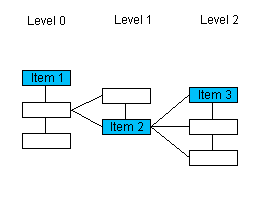| LEADTOOLS DICOM C++ Class Library Help > Classes and Member Functions > LDicomDS > LDicomDS Class Members > LDicomDS::GetLevelElement |
|
|
Available in LEADTOOLS Medical Imaging toolkits. |
#include "Ltdic.h"
L_UINT32 LDicomDS::GetLevelElement(pElement)
|
pDICOMELEMENT pElement; |
/* pointer to a DICOMELEMENT structure */ |
Returns a value that indicates the level at which the specified element is located within the Data Set.
|
Parameter |
Description |
|
pElement |
Pointer to a DICOMELEMENT structure within the Data Set. |
Returns
The level at which the specified element is located within the Data Set.
Comments
This function requires that the Data Set is evaluated as a tree.
The following illustration gives an example:

|
If the passed pointer points to |
The function returns |
|
Item 1 |
0 |
|
Item 2 |
1 |
|
Item 3 |
2 |
Required DLLs and Libraries
|
LTDIC For a listing of the exact DLLs and Libraries needed, based on the toolkit version, refer to Files To Be Included With Your Application |
Win32, x64
See Also
|
Topics: |
|
|
|
How to Disable the Automatic Loading of the default DICOM IOD Table |
Example
This example displays the level of an element.
L_INT LDicomDS_GetLevelElementExample()
{
LDicomDS* pDS;
pDICOMELEMENT pElement;
L_UINT32 nLevel;
L_TCHAR szText[30];
pDS = new LDicomDS(NULL);
pDS->InitDS( CLASS_XA_BIPLANE_IMAGE_STORAGE_RETIRED, 0);
pElement = pDS->FindFirstElement(NULL, TAG_RADIATION_SETTING, FALSE);
if (pElement != NULL)
{
nLevel = pDS->GetLevelElement(pElement);
wsprintf(szText, TEXT("%ld"), nLevel);
MessageBox(NULL, szText, TEXT("Notice"), MB_OK);
}
delete pDS;
return DICOM_SUCCESS;
}